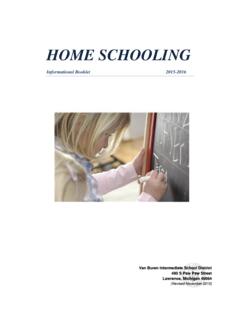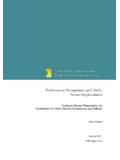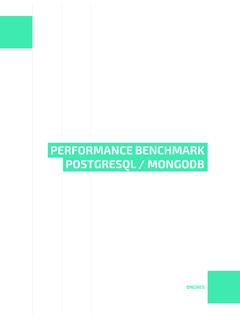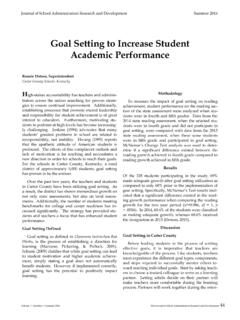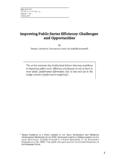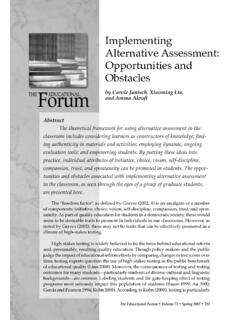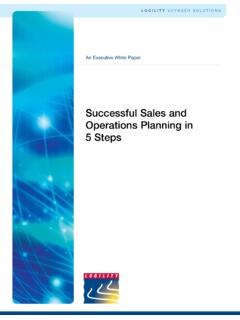Transcription of Writing Measurable Annual Goals and Benchmarks/ Short …
1 Writing Measurable Annual Goals and Benchmarks/ Short -term Objectives February 2013 Region 3 Monitors MARSE RULE OCT. 18, 2011 Individual Educational Program (a)A statement of Measurable Annual Goals , including Measurable Short -term objectives. The Office of Special Education has identified that benchmarks can be written in place of Short -term objectives. Measurable The target is written so there is evidence that the desired level of performance has been met. Measurable Must include concrete methods and criteria for assessing progress and achievement of outcomes. Allow for a calculation of how much progress is achieved. FOUNDATION OF THE GOAL The foundation on which the IEP is developed is the Present Level of Academic Achievement and Functional Performance (PLAAFP). The PLAAFP must identify the impact of the student s disability. The PLAAFP creates an effective implementation plan to leverage improved performance in academic and functional needs and the attainment of post secondary Goals for student s of transition age.
2 A well written PLAAFP will identify baseline data upon which to write Measurable Goals related to the student s needs and offer a starting point upon which to build instruction. FOUNDATION cont. The PLAAFP should identify how the student s disability impacts progress in the general education curriculum, nonacademic activities, and extra curricular activities. The present level should begin by identifying the gaps between the child s performance and the expected grade level performance on the Common Core State Standards (CCSS)or the Common Core Essential Elements (CCEE). This gap analysis will be the starting point for developing Goals . The PLAAFP must identify progress on Early Childhood Standards of Quality for pre-K children. OTHER GOAL CONSIDERATIONS Objectives/benchmarks can be written to scaffold down to the grade level standards based on the student's functioning level. Remember the goal is to close the learning gap. For students with moderate to severe (sometimes mild) cognitive impairments, Goals and objectives regarding functional skill needs should be addressed that may not be contained in the Common Core State Standards or Essential Elements.
3 Secondary transition considerations should be addressed on how the disability needs effect the student s post-secondary vision. RECOGNIZING A SMART GOAL S = Specific M = Measurable A = Attainable R = Relevant T = Time-bound A WELL WRITTEN GOAL The ending date for achieving the goal. What behavior the student will demonstrate. What level, degree, or condition the student will perform. How mastery will be evaluated. The potential for being attained in one year. MDE Model: By _____, (the student) will _____ when/at _____ date skill/behavior condition/criteria _____. assessment/evaluation SKILL/BEHAVIOR Examples Classify Convert Define Estimate Interpret Retell Locate and Use Explain Analyze Illustrate Elaborate Verbally Express Follow Directions Identify Request CONDITION/CRITERIA Examples Given a request During transition periods During social conversation When provided a Writing prompt During class discussion When reading text When given 10 problems, When shown a variety / When given a choice When using a graph When provided a visual schedule Prompts or cues: on teacher s oral request.
4 Structure: using a graphic organizer Location: in hallways during passing Memory conditions: using a number chart .. Form of communication: using a communication device Content specific: In math class .. CONDITION/CRITERIA cont. Trial based: on 9 out of 10 trials Production: in at least 9 sentences Percentage: with at least 75% accuracy Change from baseline: improve by at least 10% Behavior change: no more than 3 times a day Across sessions: on 9 consecutive attempts Time based: for 15 minutes at a time Grade-level: at the 4th grade level ASSESSMENT/EVALUATION Examples Teacher made tests End of unit test End of chapter test Graphing data Homework assignment In class work Student assignment Documented observation Point sheets Office disciplinary referrals Rubric Education achievement tests Portfolios Student s daily work Rating scale Standardized tests Service provider logs District common assessments Teacher logs Checklists REMEMBER THAT must relate directly to the needs from the Present Level of Academic Achievement and Functional Performance (PLAAFP).
5 Must identify a learning gain that is both challenging and reasonably achievable in one year, given the instruction and services he/she will receive. must contain data sources that are consistent and align with those stated in the PLAAFP. ACADEMIC EXAMPLE PLAAFP Excerpt: Mark currently reads 40 correct words per minute from the second grade level of DIBELS next Oral Reading Fluency Passages. He needs to improve his reading fluency. Annual Goal: In 36 instructional weeks, Mark will read 90 correct words per minute, as measured by the 2nd grade DIBELS next Oral Reading Fluency Passages progress monitoring data. PLAAFP Excerpt: When given a written expression probe at grade level with one minute to plan and three minutes to write, Mary is Writing 3 correct Writing sequences requiring correct spelling, capitalization, and punctuation. Mary needs to improve her Writing skills. Annual Goal: In 36 instructional weeks, Mary will complete a story starter scored for correct spelling, punctuation, and capitalization with 12 correct Writing sequences, as measured by 3 minute Writing samples collected on progress monitoring dates.
6 SOCIAL/EMOTIONAL, BEHAVIORAL EXAMPLE PLAAFP Excerpt: Based on Office Disciplinary Referrals (ODRs) and direct observational logs, the student becomes physically aggressive (pushing, hitting, and spitting) toward peers in settings that require transitions under reduced supervision. The student is currently able to transition without physical aggression 60% of the time. Annual Goal: By March 2014, the student will demonstrate skills to transition under reduced supervision in multiple school settings 80% of the time as measured by observational logs and ODR s. DEVELOPING OBJECTIVES/BENCHMARKS The MDE guidance includes the following required elements: criteria at what level and under what conditions will objective be achieved procedure what method used to document performance schedule the frequency of the evaluation procedure Objectives/benchmarks are intermediate steps designed to achieve the Annual goal. Writing Goals AND OBJECTIVES/BENCHMARKS Measurable Goals with a number of separate but relevant Measurable objectives.
7 Measurable Goals with a number of time-limited benchmarks for the Goals . Objectives/benchmarks are intermediate steps designed to achieve the Annual goal. PERFORMANCE CRITERIA Within 5 minutes 3 out of 4 trials 4 times weekly For 40% of trials 2 times daily For 5 consecutive sessions EVALUATION PROCEDURE At least 70% 7 out of 10 trial periods 5 consecutive trial days 5 consecutive weeks 8 out of 10 trial counts With a rate of 80 wpm EVALUATION SCHEDULE Daily Weekly Bi-weekly Monthly Following summative assessment Every six weeks THE USE OF BENCHMARKS allow for the changing of interventions used without revising the IEP. focus is always on the goal. create an aim line to monitor student growth. BENCHMARKS vs. Short -TERM OBJECTIVES Short -TERM OBJECTIVES One overarching target for the year Different Short -term objectives (skills) to achieve the goal Skill based May be better for non-curricular type of Goals BENCHMARKS Target tracking to successful completion of Annual goal Benchmarks are the Goals , but with progressive growth each marking period Concept based Professional flexibility Better alignment to standards BENCHMARKS PLAAFP Excerpt: Mark currently reads 40 correct words per minute from the 2nd grade level of DIBELS next Oral Reading Fluency Passage.
8 Mark needs to improve his word recognition skills. benchmark 1: By the end of the 1st marking period of 2012, Mark will read 50 correct words per minute from a 2nd grade level of the oral reading fluency passages, as measured weekly. benchmark 2: By the end of the 2nd marking period of 2012, Mark will read 65 correct words per minute from a second grade reading fluency passage, as measured weekly. GOAL: In 36 instructional weeks, Mark will read 90 correct words per minute, as measured by 2nd grade DIBLELS next Oral Reading Fluency Passages progress monitoring data. PLAAFP Excerpt: When given a written expression district probe at grade level with one minute to plan and three minutes to write, Mary is Writing 3 correct Writing sequences requiring correct spelling, capitalization, and punctuation. Mary needs to improve her Writing skills. benchmark 1: By the end of the 3rd marking period, Mary will complete the written expression probe scored for correct spelling, capitalization, and punctuation with 5 correct Writing sequences per 3 minute sample, as measured weekly.
9 benchmark 2: By the end of the 4th marking period, Mary will complete the written expression probe scored for correct spelling, capitalization, and punctuation with 8 correct Writing sequences per 3 minute sample, as measured weekly. GOAL: In 36 instructional weeks, Mary will complete a story starter scored for correct punctuation, spelling, and capitalization with 12 correct Writing sequences, as measured by 3 minute Writing samples collected on progress monitoring dates. OBJECTIVES PLAAFP Excerpt: Based on Office Disciplinary Referrals (ODRs) and direct observational logs, the student becomes physically aggressive (pushing, hitting, and spitting) toward peers in settings that require transitions under reduced supervision. The student is currently able to transition without physical aggression 60% of the time. Annual Goal: By March 2014, the student will demonstrate skills to transition under reduced supervision in multiple school settings 80% of the time as measured monthly by observational logs and ODRs.
10 STO 1: The student will demonstrate skills to transition without physical aggression while going to and from the cafeteria 80% of the time as measured monthly by observational logs and ODRs. STO 2: The student will demonstrate skills to transition without physical aggression while exiting and entering the building 80 % of the time as measured monthly by observational logs and ODRs. DOCUMENT, DOCUMENT, DOCUMENT PROGRESS REPORT Status areas should be completed at the time of the district s periodic reports with a clear narrative description of the student s progress Must include: the date of the periodic report the progress toward the Annual goal as defined by the Short -term objective/ benchmark Defines the reporting schedule Identifies the responsible position(s) NATURE OF EFFECTIVE Goals AND OBJECTIVES/BENCHMARKS Ensure students have access to and make progress in the general curriculum. Set a challenging, yet realistic Annual goal. Implement interventions that prove successful by data collection.


